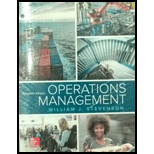
Concept explainers
a)
To draw: A decision tree for the given problem.
Introduction:
Decision tree is one of the methods used in decision-making process. It would graphically represent the available alternatives and states of nature. It would also mention the payoffs and probabilities of the alternatives. It helps to choose the best alternative that would give the best result among the alternatives.
a)
Explanation of Solution
Given information:
Three decision alternatives:
- 1st construct small stamping plant
- 2nd construct medium stamping plant
- 3rd construct stamping plant
Each decision has demand:
- Low demand which have 20% probability
- Low demand which have 80% probability
- If firm build small facility and demand turn out to be low than
NPV is $42,000,000 - If firm build small facility and demand turn out to be high than either subcontract or expand greatly, if sub contract than NPV is $42,000,000 and if expand greatly than $48,000,000.
- If firm build medium facility and demand turn out to be low than NPV is $22,000,000.
- If firm build medium facility and demand turn out to be high than either it do nothing or expand, if sub contract than NPV is $46,000,000 and if expand greatly than $50,000,000.
- If firm build large facility and demand turn out to be low than NPV is -$20,000,000.
- If firm build large facility and demand turn out to be high than NPV is $72,000,000.
As per given information, construct the decision tree:
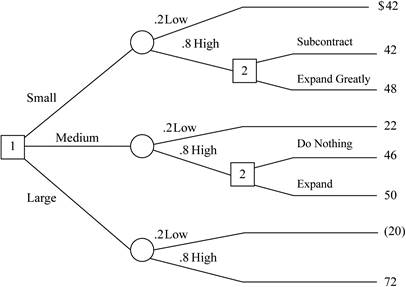
Now, calculate the value of payoff and monetary value in decision tree:
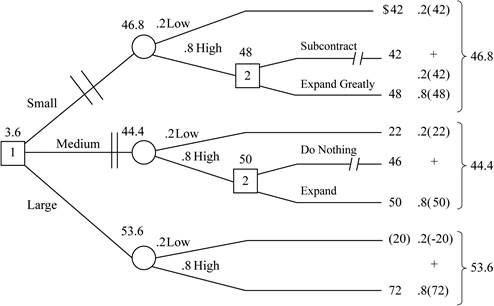
Analysis the decision from right to left:
- In the decision tree, there are two decisions making; first decision is between small, medium and large and second decision is between high demand of small and medium build facilities.
- If small facilities build with high demand then select expand greatly because the payoff of expand greatly is higher than subcontract. The payoff of expand greatly is $48,000,000 and place double slash (reject) on subcontract.
- If large facility build with high demand then select expand, because the payoff of expand greatly is higher than do nothing. The payoff of expand is $50,000,000 place double slash (reject) on do nothing.
Calculate the product of the chance probabilities and their respective payoffs for the remaining branches:
- If small facility build:
Low demand= (Probability× NPVsmall,low)=(20%×$42,000,000)=$8,400,000
High demand= (Probability× NPVsmall,high)=(80%×$48,000,000)=$38,400,000
- If medium facility IS build:
Low demand= (Probability× NPVmedium,low)=(20%×$22,000,000)=$4,400,000
High demand= (Probability× NPVmedium,high)=(80%×$50,000,000)=$40,000,000
- If large facility is build:
Low demand= (Probability× NPVlarge,low)=(20%×−$20,000,000)=−$4,000,000
High demand= (Probability× NPVmedium,high)=(80%×$72,000,000)=$57,600,000
Calculation of the expected value in each alternative:
- If small facility build
Expected value=(Low demand payoff+high demand payoff)=($8,400,000+$38,400,000)=$46,800,000
- If medium facility build
Expected value=(Low demand payoff+high demand payoff)=($4,400,000+$40,400,000)=$44,400,000
- If large facility build
Expected value=(Low demand payoff+high demand payoff)=(−$4,00,000+$57,600,000)=$53,600,000
Here, it is obtained that large facility build have higher expected value, hence it should be selected. And small and medium facilities have to be rejected.
b)
To determine: Maximin alternatives
Introduction:
Maximin is the decision making method which is used to make decision under uncertainty. This method will find an alternative that maximizes the minimum outcome of every alternative or we can say that calculating the minimum outcome within the each alternative.
b)
Answer to Problem 9P
Explanation of Solution
Determine the worst possible alternatives from the given demand:
As definition stated above, Maximim is the selection from the best of the worst possible payoff for each alternatives.
| Alternative | Next Year’s Demand | Worst Payoff | Decision | |
| Low | High | |||
| Small | $42,000,000.00 | $48,000,000.00 | $42,000,000.00 | Best of the Worst |
| Medium | $22,000,000.00 | $50,000,000.00 | $22,000,000.00 | |
| Large | -$20,000,000.00 | $72,000,000.00 | -$20,000,000.00 | |
Hence, the best decision according to Maximin decision is to select a small medium facility.
c)
To determine: Expected value of perfect information (EVPI) and interpret it.
Expected value of perfect information: It is the rate that a person is willing to pay to gain access to perfect information. A common area which uses expected value of perfect information is the healthcare economy. This value tries to evaluate the expected cost of the uncertainty, which can be interpreted as the expected value of perfect information
The expected value of perfect information can be calculated by using below given formula:
EVPI = Expected value with perfect information−Maximum EMV
c)
Answer to Problem 9P
Explanation of Solution
Calculate the expected value with perfection information or Expected payoff under certainty:
EVwPI= ∑Max(Alternative payoff)× Probability state of nature =(42,000,000×20%)+($72,000,000×80%)=$66,000,000
Calculate the expected value with perfect information:
EVPI = Expected value with perfect information−Maximum EMV =$66,000,000−$53,600,000=$12,400,000
Therefore, EVPI is $12,400,000.
d)
To determine: The sensitive analysis on P (high).
Introduction
Decision table is formats or visual representations were data is expressed arranged, determined and calculated to make a effective decision making. A decision table is a tabular representation that is used to analyze decision alternatives and states of nature.
d)
Explanation of Solution
Explanation
Here we draw each alternative to P (high), low demand should be on the left hand side and high demand value on the right hand side:
| Next Year’s Demand | ||
| Alternative | Low | High |
| Small | $42,000,000.00 | $48,000,000.00 |
| Medium | $22,000,000.00 | $50,000,000.00 |
| Large | -$20,000,000.00 | $72,000,000.00 |
Graph plot:
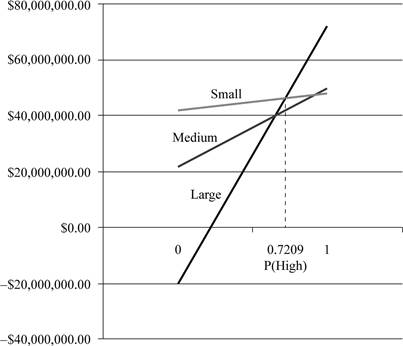
From the above graph, we can determine the value of P (high) where each alternative are optimal.
From the graph, we can obtain that small build facility is best option, because of higher expected value. For low value of P(high) while for higher and intermediate value of P(high) large is the best option.
Calculate the range needed to determine upper part of line intersects:
For each line, b is the slope of the line and x = P(High). The slope of each line Right hand value−Left hand value.
Determination of equation:
Small build facility = 42+6P (because high demand $48 million which is subtracted with low demand value $42 million)
Large build facility =-20+92P (because high demand $72million which is subtracted with low demand value -$20million)
Determination of intersection between small and large
42 + 6P=−20 + 92P6P – 92P = −20 – 42−86P = −62P = −62−86=0.7209
Hence, the intersection between small and large is 0.7209.
Therefore, optimal range can be derived as:
Small: P (High) = 0 to < .7209
Large: P (High) > .7209 to 1.00
Want to see more full solutions like this?
Chapter 5 Solutions
Loose Leaf for Operations Management (The Mcgraw-hill Series in Operations and Decision Sciences)
- Agree or disagree with the post When you get an insulting offer, the best thing to do is stay calm and professional. Try not to take it personally or react out of anger. Instead, ask questions to understand why the offer was so low. This helps you get a better idea of what the other person is thinking. After that, you can respond with a counteroffer that shows your value. Use simple facts like your skills, experience, and what others in your field are getting paid to back up your request. If the person still refuses to offer something fair, it’s okay to politely say no and walk away. Standing up for yourself in a respectful way shows confidence and helps others take you seriously. Agree or disagree with the postarrow_forwardRegarding perceptions that can occur when negotiating in different places and at different times, the continuation norm in e-negotiations is best described as _____. Group of answer choices A. negotiators' beliefs that negotiations are worth continuing B. the act of thinking about how things might have turned out differently C. the tendency for e-communicators to ascribe diabolical intentions to the other party D. the tendency for negotiators to behave as if they are communicating synchronously when in fact they are notarrow_forwardIn any discussion or meeting, there is a tendency for a minority of people to do most of the talking. A key determinant of who dominates the conversation is _____. Group of answer choices A. their status within the group B. their network of social connections C. their gender D. their agearrow_forward
- With regard to intergenerational negotiation, the _____ generation has vast numbers of relationships but few of them are deep. They spend more time communicating virtually than face-to-face. Their personal and work networks are vital to their on-the-fly learning and problem-solving skills. Armed with tools for working anywhere at any time, this generation puts more value in leading a balanced life and flexibility with their work and life demands. Group of answer choices A. mature B. boomer C. millennial D. Generation Xarrow_forwardIf a negotiator has less power than the counterparty and an unattractive BATNA, which communication medium might help the less-powerful negotiator claim more resources?arrow_forwardCould you help explain what the foundations of faith are? What are their strategies?arrow_forward
- Hi! Can you guys help me with this? Thank you! Please write-up summarizing the core message of the movie/documentary and the connection to the course material The documentary is Poisoned: The Dirty Truth About Your Food directed by Stephanie Soechtig from Netflix. * Here are the course material: Global Logistics Global Transportation; Global Inventory Management Global Operation Global Market Channels Purchasing Stategies: Outsourcing; Offshoring; Nearshoring; Multi-sourcing & Co-sourcing Make or Buy decisions Global Supply Chain Infrastructure: Transportation Infrastructure; Communication Infrastructure; Utilities Infrastructure; Technology Infrastructure Supply Chain Risks: • Supply Risks – disruption of supply, inventory and schedules. • Operational Risks – breakdown of operations, changes in technologies. • Demand Risks – variations in demand.• Security Risks – theft, sabotage, terrorism, counterfeiting.• Macro Risks – economic shifts, recession, wage hikes, varying…arrow_forwardHi! Can you guys help me with this? Thank you! Please write-up summarizing the core message of the movie/documentary and the connection to the course material The documentary is American Factory by Steven Bognar & Julia Reichert from Netflix * Here the course material: Global Logistics Global Transportation; Global Inventory Management Global Operation Global Market Channels Purchasing Stategies: Outsourcing; Offshoring; Nearshoring; Multi-sourcing & Co-sourcing Make or Buy decsions Global Supply Chain Infrastructure: Transportation Infrastructure; Communication Infrastructure; Utilities Infrastructure; Technology Infrastructure Supply Chain Risks: • Supply Risks – disruption of supply, inventory and schedules. • Operational Risks – breakdown of operations, changes in technologies. • Demand Risks – variations in demand.• Security Risks – theft, sabotage, terrorism, counterfeiting.• Macro Risks – economic shifts, recession, wage hikes, varying exchangerates.• Policy Risks –…arrow_forward1) View the video Alton Bridge (12.16 mins, Ctrl + Click on the link), and please answer the following questions: https://meida.gaspar.mheducation.com/GASPARPlayer/play.html?id=24qHEm8aNZExFciJtZQbqli a) According to the video, what are the various steps involved in managing projects? b) What were the different phases of the Alton Bridge project? c) What are the two widely used scheduling techniques, and under what phase of the Alton Bridge project are they discussed? Note: As a rough guideline, please try to keep the written submission to a paragraph or so for each of the questions. 2) The following is a table of activities associated with a mining project at Lunar Industries, their durations, and what activities each must precede: Activity Duration (weeks) Precedes A (start) 1 B, C B 1 E C 4 F E 2 F F (end) 2 - The AOM project diagram is as given below: a) What is the critical path (list all activities in the…arrow_forward
- 1) View the video Alton Bridge (12.16 mins, Ctrl + Click on the link), and please answer the following questions: a) According to the video, what are the various steps involved in managing projects? b) What were the different phases of the Alton Bridge project? c) What are the two widely used scheduling techniques, and under what phase of the Alton Bridge project are they discussed? Note: As a rough guideline, please try to keep the written submission to a paragraph or so for each of the questions. 2) The following is a table of activities associated with a mining project at Lunar Industries, their durations, and what activities each must precede: Activity Duration (weeks) Precedes A (start) 1 B, C B 1 E C 4 F E 2 F F (end) 2 - The AOM project diagram is as given below:arrow_forwardWith all the problems companies are currently facing, why do so many choose to expand into international markets? What are the advantages of expanding beyond the domestic market?arrow_forwardPerform resource leveling. Assume that each task can be performed independently of the other tasks.arrow_forward
 Practical Management ScienceOperations ManagementISBN:9781337406659Author:WINSTON, Wayne L.Publisher:Cengage,
Practical Management ScienceOperations ManagementISBN:9781337406659Author:WINSTON, Wayne L.Publisher:Cengage,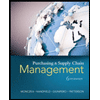 Purchasing and Supply Chain ManagementOperations ManagementISBN:9781285869681Author:Robert M. Monczka, Robert B. Handfield, Larry C. Giunipero, James L. PattersonPublisher:Cengage LearningMarketingMarketingISBN:9780357033791Author:Pride, William MPublisher:South Western Educational Publishing
Purchasing and Supply Chain ManagementOperations ManagementISBN:9781285869681Author:Robert M. Monczka, Robert B. Handfield, Larry C. Giunipero, James L. PattersonPublisher:Cengage LearningMarketingMarketingISBN:9780357033791Author:Pride, William MPublisher:South Western Educational Publishing Management, Loose-Leaf VersionManagementISBN:9781305969308Author:Richard L. DaftPublisher:South-Western College Pub
Management, Loose-Leaf VersionManagementISBN:9781305969308Author:Richard L. DaftPublisher:South-Western College Pub




